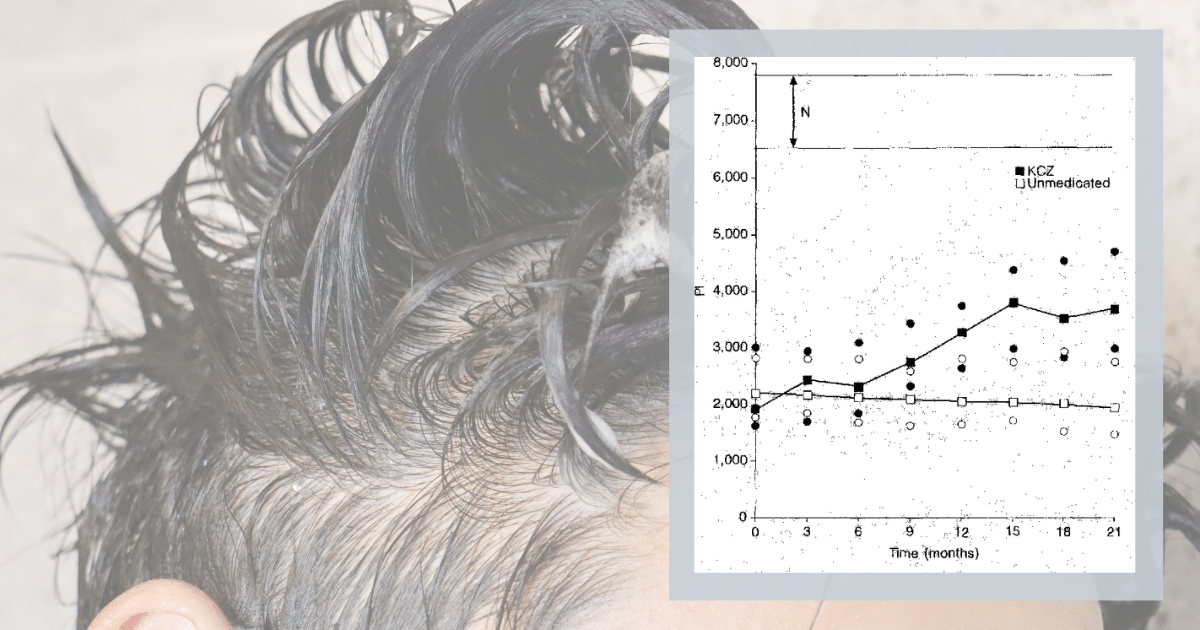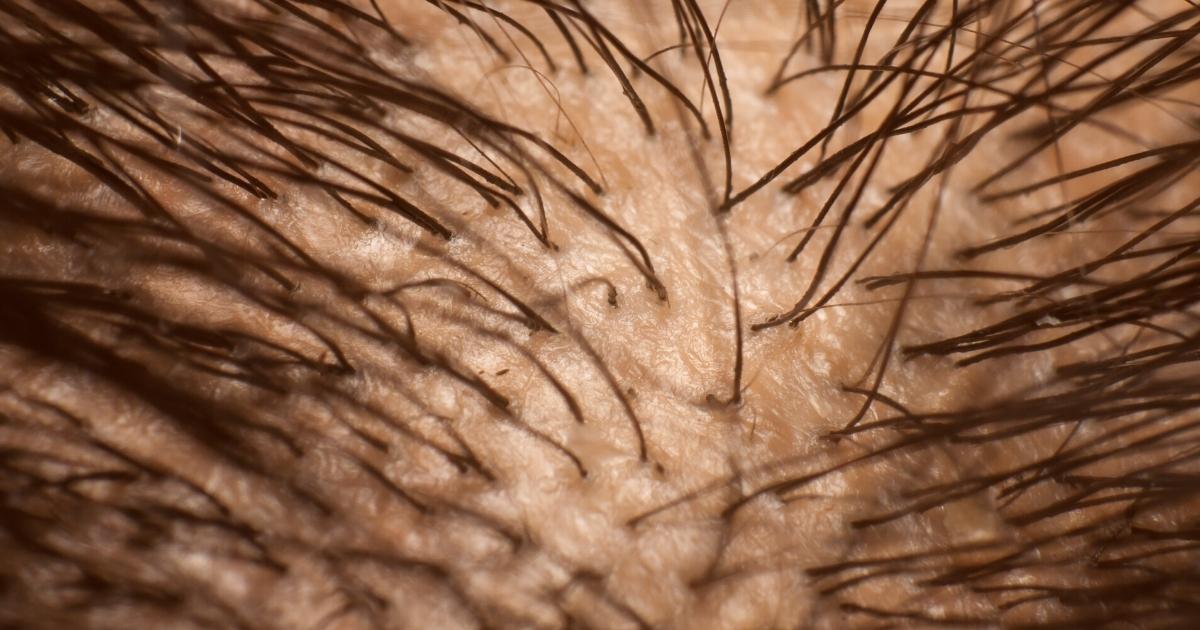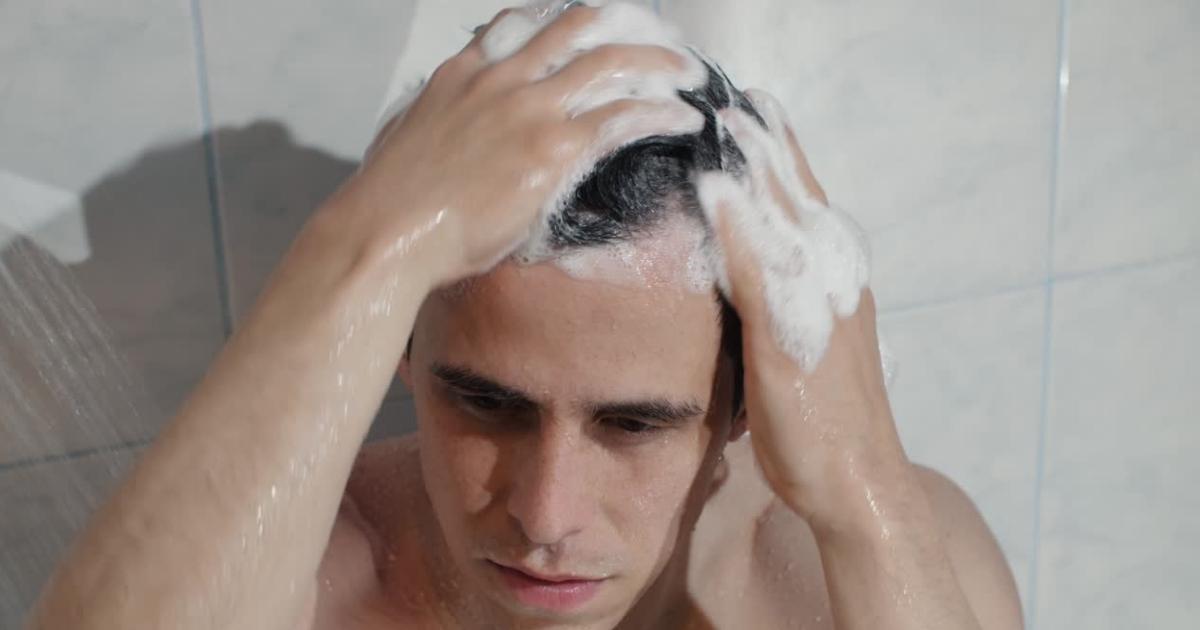Anyone searching “How to reverse hair loss online” has undoubtedly come across the Big Three protocol: minoxidil (Rogaine®), finasteride (Propecia®), and ketoconazole shampoo (Nizoral®).
What many might not know: despite ketoconazole’s popularity, it’s not actually FDA-approved for pattern hair loss, nor is it as well-researched as minoxidil or finasteride.
In fact, there are just a few human studies on Nizoral for hair loss and even fewer on people with just androgenic alopecia, the most common form of hair thinning in men.
Is Ketoconazole Worthy of Big Three Status?
Here we’ll uncover the evidence on ketoconazole for hair regrowth. We’ll cut straight-to-the-facts about ketoconazole, its effects on hair loss, and whether or not this shampoo is a good fit. Along the way, we”ll also uncover…
- Which formulation is better: 1% or 2% ketoconazole
- Why not everyone is a good candidate for ketoconazole
- How to (potentially) increase ketoconazole’s efficacy (see our before-after photos)
- Who needs to worry about ketoconazole’s potential side effects
Nizoral for Hair Loss: Overview
- Effort: Low (used as shampoo just 2-3 times per week)
- Expectations: According to studies so far, hair loss improvement is observed after 3-6 months
- Response rate: 80%+
- Regrowth rate: ~5% alone; 25-40% if combined with microneedling and/or finasteride and/or minoxidil
- Cost: Low ($10-$20 per bottle of 100ml, which should last two months)
- Problems: Not as well-studied as finasteride or minoxidil; 2% formulations work better but generally require a prescription (though this can be circumvented online); less studied on women (though it’s likely just as effective)
Key Takeaways
Ketoconazole is a low-cost, low-effort shampoo with practically no side effects. It’s clinically shown to help improve hair loss from both androgenic alopecia (AGA) and telogen effluvium (TE).
While 1% ketoconazole is available over the counter, 2% ketoconazole usually requires a doctor’s prescription. Studies show that 2% ketoconazole is more effective, particularly in helping to normalize excessive hair shedding from rapid-onset AGA and/or TE. [1]https://pubmed.ncbi.nlm.nih.gov/9669136/
Can Nizoral help with hair growth?
If a 2% prescription-strength formulation is used, yes.
By itself, ketoconazole is unlikely to stimulate hair regrowth on par with finasteride or combination therapies. So, ketoconazole is just one part of a multi-pronged hair loss regimen. This shampoo may have synergistic effects with stimulation-based therapies like microneedling, massaging, and/or platelet-rich plasma therapy. It also seems to pair well with most FDA-approved / FDA-cleared treatments like finasteride, minoxidil, and low-level laser therapy.
While oral ketoconazole comes with significant risks of side effects, 2% ketoconazole shampoo seems to carry little (if any) risks of side effects – mainly because of its low time of exposure and systemic absorption versus its oral formulations.
The best candidates for 2% ketoconazole shampoo are hair loss sufferers who are comfortable using the shampoo 2-3 times per week and who are dealing with dandruff and/or excessive hair shedding from AGA or TE.
More information on the science behind ketoconazole – its mechanisms of action, supporting evidence, expectations for hair regrowth, and contraindications – can be found below.
What Is Ketoconazole?
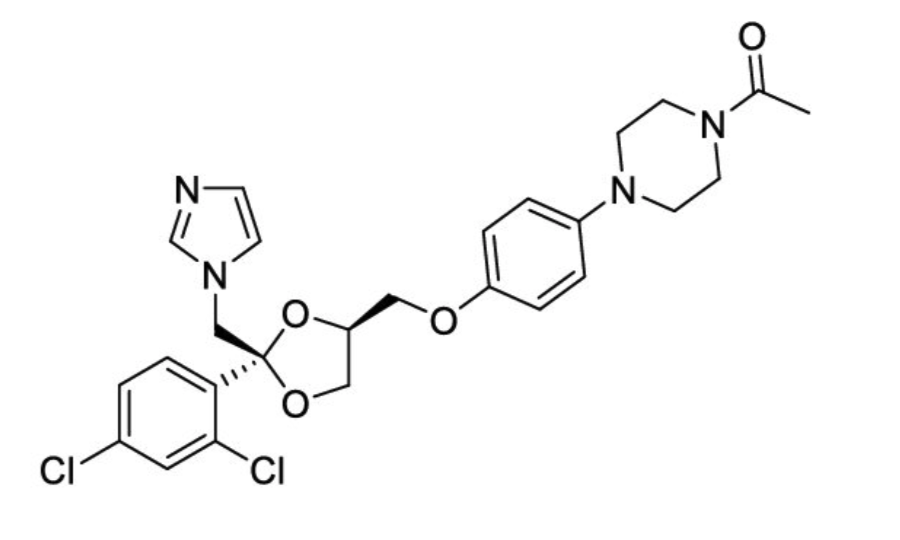
Ketoconazole is more commonly mentioned by the brand name Nizoral®, and most people know about it as a shampoo.
Simply put, ketoconazole is an anti-fungal medication. It’s a drug commonly used to help improve fungal-related conditions – like dandruff, fungal infections, certain hormone-linked diseases, and even hair loss from fungal and non-fungal causes.
If it’s a fungal medication, why is it used for hair loss?
Because ketoconazole’s mechanisms of action – as an anti-fungal, anti-inflammatory, anti-androgenic, and pro-anagen agent – all overlap with the causes of telogen effluvium and androgenic alopecia.
Here’s how.
Ketoconazole’s anti-fungal properties help fight off yeast, fungi, and bacterial infections that can cause excessive hair shedding.
As an anti-fungal medication, ketoconazole may also have anti-inflammatory effects, especially in hair follicle sites.[2]https://www.ncbi.nlm.nih.gov/pubmed/9669136
Many yeast, fungi, and bacteria feed off our dead skin as well as the oils our skin produces (i.e., sebum) which helps to lubricate our hair. Resultantly, these species can often be found residing in parts of our hair follicle – specifically, the infundibulum (i.e., the upper third of each hair shaft) and sebaceous glands.
However, sometimes too many yeast, fungi, and/or bacteria may colonize our sebaceous glands – leading to over-colonization. This is particularly true with the fungus-like yeast species Malassezia spp., which is found in 65% of healthy scalps.[3]https://www.ncbi.nlm.nih.gov/pmc/articles/PMC4367942/
Many of these species produce toxic byproducts (i.e. porphyrins) as part of their digestion of sebum. In cases of over-colonization, the accumulation of toxins elicits an inflammatory response in the sebaceous gland. Ironically, the body often responds by sending more sebum to the sebaceous glands – which would help to otherwise resolve the inflammation, but not in these instances. Rather, the excess sebum simply feeds these pathogenic microorganisms, and the process continues.
This is known as a sebum-feedback loop. At moderate levels, it leads to excessive dandruff. At higher levels, it triggers excessive hair shedding – often characterized as microorganism-driven telogen effluvium (TE).
Enter ketoconazole – a potent anti-fungal medication that can help kill off these pathogens and, in doing so, stop this feedback loop.
Ketoconazole damages the cell membranes of fungi and yeast.[4]https://pubchem.ncbi.nlm.nih.gov/compound/Ketoconazole Specifically, it stops a fungus from producing ergosterol – a crucial part of the cell membrane that helps keep cellular content from leaking out as well as unwelcome substances from invading.
The end result?
Ketoconazole helps kill off pathogenic yeast/fungi, which then reduces scalp inflammation and helps resolve any excessive hair shedding (TE).
This is also why ketoconazole is such an effective treatment for scalp conditions caused by fungi – like dandruff and seborrheic dermatitis. Those conditions are also often caused by Malassezia spp. – the fungus-like yeast that is (fortunately) hypersensitive to ketoconazole.
Ketoconazole might help reduce inflammation in 30-50% of men with androgenic alopecia
Research shows that 30-50% of hair loss sufferers with androgenic alopecia (AGA) also have P. acnes and/or Malassezia spp. infections in the scalp. Just like with TE, the presence of these microbes may exacerbate inflammation, induce early hair shedding, and thereby accelerate the progression of AGA.
In these cases, anti-fungal and/or antibacterial shampoos tend to be useful – because they help to reduce the infections that are accelerating hair shedding in AGA.
Ketoconazole might have anti-androgenic effects in scalp tissues
Ketoconazole isn’t just an anti-fungal; it also has anti-androgenic properties when taken orally. And, while researchers have debated whether these findings extend to topically applied ketoconazole, at least one peer-reviewed paper makes a strong argument in its favor.
Specifically, this hypothetical model argues that topically applied ketoconazole has anti-androgenic properties.[5]https://www.ncbi.nlm.nih.gov/pubmed/14729013 In particular, it may help reduce dihydrotestosterone (DHT) – the main hormone implicated in AGA – and in two ways:
- Inhibits 5-alpha reductase. This is an enzyme that converts free testosterone into DHT.
- Blocks androgen receptors. Androgen receptors are where DHT attaches to a cell to influence tissue function (i.e., hair follicle miniaturization). If androgen receptors are blocked, DHT cannot bind to these cells, and thus does not affect that tissue’s functionality.
Together, if ketoconazole has enough of a DHT-reducing effect in balding scalp tissues, it should help to improve AGA – similar to the ways in which treatments like finasteride work.
Ketoconazole may prolong the anagen phase of the hair growth cycle
At any given moment, roughly 85% of scalp hairs are in their growth (anagen) phase, while remaining hairs are either in a resting (catagen) or shedding (telogen) phase.
One defining characteristic of telogen effluvium (TE) is a large increase in the number of shedding versus growth phase hairs (i.e., increased telogen:anagen ratio). In TE, it’s not uncommon to see telogen:anagen ratios of 40-50% and beyond.
This is also observed in androgenic alopecia (AGA) – though to a lesser degree, as AGA is characterized more so by hair follicle miniaturization, less so by hair shedding.
Interestingly, one research team demonstrated that, for reasons unknown, ketoconazole appears to prolong the anagen (growth) phase of hair follicles affected by TE and/or AGA.[6]https://www.ncbi.nlm.nih.gov/pubmed/18498517
This effect should help delay the progression of both conditions, and maybe even partially reverse them.
Summary of Mechanisms
Ketoconazole might improve telogen effluvium by:
- Killing off pathogens in the scalp, thus normalizing excessive hair shedding triggered by microorganism-mediated inflammation
- Prolonging the anagen phase of the hair cycle
Ketoconazole might improve androgenic alopecia by:
- Killing off pathogens in the scalp, thus normalizing excessive hair shedding triggered by microorganism-mediated inflammation
- Reducing scalp DHT levels by inhibiting 5-alpha reductase and blocking androgen receptors
- Prolonging the anagen phase of the hair cycle
Altogether, these mechanisms suggest that ketoconazole may improve both TE and AGA. So, what’s the evidence in human studies?
Clinical studies: is ketoconazole effective for hair loss?
As is always the case with hair loss research, context is key. And when looking into the effectiveness of ketoconazole, we need to evaluate all clinical studies with several things in mind:
- Was the ketoconazole tested on androgenic alopecia or other hair loss disorders?
- Was the formulation strength 1% or 2%?
- What, exactly, was measured?
To date, there are only four clinical studies on ketoconazole and hair loss (that we could find). As such, we’ll present them in detail. If you’d like, you can skip to the summaries of each study.
Ketoconazole Shampoo: Effect of Long-Term Use in Androgenic Alopecia
Full text: Piérard-Franchimont et al., 1998 [7]https://www.ncbi.nlm.nih.gov/pubmed/9669136
Study one: 2% ketoconazole versus a normal shampoo
- Who: 39 male only-AGA-subjects
- What: 2% ketoconazole shampoo versus a normal shampoo. During the study duration, 27 men used ketoconazole while 12 men used normal shampoo. There were also 22 non-AGA-controls – half of them testing ketoconazole; half of them trying normal shampoo.
- How long: 2-4 times per week for 21 months
- Measurement: AGA pilary index (PI). This was defined as the percentage of hairs in anagen (A) x average diameter (D, μm) of the hair shafts 1.5 cm from the hair bulb.
- Results:
- PI of non-AGA-controls remained unchanged, no matter the type of shampoo used (ketoconazole versus normal shampoo).
- PI of only-AGA-subjects with unmedicated shampoo showed a slow linear decrease over time, while the ketoconazole group “yielded a progressive PI increase that became evident after a 6-month survey and apparently reached a plateau value after about 15 months”.
- Takeaways:
- In men without androgenic alopecia, ketoconazole doesn’t improve anagen hair counts or hair shaft diameter
- In men with androgenic alopecia, ketoconazole improves both anagen hair counts and overall hair shaft diameter
Study two: 2% ketoconazole versus 2% minoxidil
- Who: 8 male only-AGA-subjects; 4 using ketoconazole, and 4 using minoxidil
- What: 2% ketoconazole shampoo (vs. 2% minoxidil lotion)
- How long: ad libitum (i.e., as often as desired) for 6 months
- Measurements: hair density; hair shaft diameter and the corresponding sebaceous gland
- Results:
- “A 7% increase in the median hair shaft diameter was yielded by both the [ketoconazole] shampoo and minoxidil + unmedicated shampoo combination.”
- “A 19.4% decrease in the mean sebaceous gland area was observed in the [ketoconazole] group. In contrast, the same variable increased by 5.3% in the minoxidil + unmedicated shampoo group.”
- Ketoconazole improved density of hair by 18% compared to minoxidil by 11%.
- Takeaways:
- Ketoconazole increases hair shaft diameter by 7%, similar to minoxidil
- Ketoconazole decreases sebaceous gland size by nearly 20% – possibly due to its anti-fungal effects. In other words, ketoconazole kills off pathogens that over-colonize, and thereby over-enlarge, the sebaceous glands. This was unique to ketoconazole (minoxidil did not have this effect).
- Ketoconazole improves hair density nearly twice as well as minoxidil
Key points:
These studies are all on men with AGA only, all of whom tested 2% ketoconazole as a shampoo.
The results all show significant improvements to hair density, as well as prolonged anagen phases and hair diameter. Moreover, one study also found that ketoconazole decreased sebaceous gland size – most likely a result of its ability to kill off pathogens overcrowding those sebaceous glands. For these reasons, it’s not unreasonable to assume that ketoconazole might also decrease sebum output.
Nudging hair shedding by antidandruff shampoos. A comparison of 1% ketoconazole, 1% piroctone olamine, and 1% zinc pyrithione formulations
Full text: Piérard-Franchimont et al., 2002 [8]https://onlinelibrary.wiley.com/doi/abs/10.1046/j.1467-2494.2002.00145.x
- Who: 150 men presenting with telogen effluvium related to androgenic alopecia associated with dandruff, separated into three groups with different shampoos: 50 men on 1% ketoconazole, 50 on 1% piroctone olamine, and 50 on 1% zinc pyrithione
- What: 1% ketoconazole shampoo versus two other anti-dandruff shampoos
- How long: 2-3 times a week, for 6 months
- Measurements: hair shedding, hair density, anagen hair percentage, mean proximal hair shaft diameter, sebum excretion rates
- Results:
- Pruritus and dandruff cleared rapidly in all three shampoo groups
- Hair density remained unchanged in all three shampoo groups
- Hair shedding decreased by 17.3% in the ketoconazole group, 16.5% in the piroctone olamine group, and 10.1% in the zinc pyrithione group
- Anagen hair ratio increased by 4.9% in the ketoconazole group, 7.9% in the piroctone olamine group, and 6.8% in the zinc pyrithione group
- Sebum excretion rate decreased by 4.8% in the ketoconazole group, 2.9% in the piroctone olamine group, and 5.5% in the zinc pyrithione group
Key points:
The men featured in this study have telogen effluvium and androgenic alopecia. And, encouragingly, it seems like 1% ketoconazole shampoo 2-3 times per week lessened hair shedding by ~20%, increased hair shaft thickness by ~5%, and decreased sebum output by ~5%.
The bottom-line: comparing across studies, 1% ketoconazole isn’t as impressive as 2%, but the results are still there. For men (and women) suffering from both TE and AGA, 1% or 2% ketoconazole might be a great intervention (among other treatments).
Comparative Efficacy of Various Treatment Regimens for Androgenetic Alopecia in Men
Full text: Khandpur et al., 2002 [9]https://www.ncbi.nlm.nih.gov/pubmed/12227482
- Who: 100 male only-AGA-subjects randomized into four groups:
- 30 finasteride
- 36 finasteride + minoxidil
- 24 minoxidil
- 10 finasteride + ketoconazole
- What: 2% ketoconazole shampoo + finasteride 1mg oral/day (vs. finasteride vs. finasteride + 2% minoxidil vs. 2% minoxidil)
- How long: 3 times a week for 1 year
- Measurements: patients’ self-assessment and physicians’ assessment. Photographs were taken.
- Results: finasteride + minoxidil and finasteride + ketoconazole reap the best improvement scores for both self- and physician-assessments. However, finasteride + minoxidil slightly outperformed finasteride + ketoconazole.
Key points:
2% ketoconazole works well as a combination therapy with finasteride.
Pilot Study of 15 Patients Receiving a New Treatment Regimen for Androgenic Alopecia: The Effects of Atopy on AGA
Full text: A.W. Rafi et al., 2011 [10]https://www.ncbi.nlm.nih.gov/pubmed/22363845
- Who: 15 AGA subjects with either atopic dermatitis or seborrheic dermatitis
- What: 2% ketoconazole shampoo. 8 subjects used NuH Hair + finasteride + minoxidil + ketoconazole, 5 using only NuH Hair, 1 using NuH Hair + finasteride + ketoconazole, 1 using NuH Hair + ketoconazole (a subject with seborrheic dermatitis)
- How long: ketoconazole usage 2-3 times a week for 9 months
Measurements: Average time for hair regrowth, photo and investigator assessments - Results:
- Average time for hair regrowth
- 30 days with NuH Hair + finasteride + minoxidil + ketoconazole
- 30 days with NuH Hair + finasteride + ketoconazole
- 60 days with NuH Hair + ketoconazole
- 90 days with NuH Hair alone
- Average time for hair regrowth
Key points:
Ketoconazole works well as a combination therapy with finasteride and minoxidil, and it can also improve AGA even in men with atopic and/or seborrheic dermatitis.
Key points summary of clinical trials
- By itself and as a combination therapy, 2% ketoconazole improves AGA and TE by:
- Increasing anagen (growth) hairs
- Increasing hair shaft diameter
- Increasing hair density
- Hair improvements from 2% ketoconazole seem to sustain, not wane (at least over 21 months of use)
- 2% ketoconazole increases hair density; 1% ketoconazole doesn’t
Very broadly speaking, ketoconazole alone might be a little bit less effective than minoxidil alone, but it also seems to be a better bet in some respects: more people respond to Nizoral for hair loss, its effects don’t wane over 21 months, and it targets AGA from multiple angles.
Applying Ketoconazole
If you want to get the most out of ketoconazole, here are some tips to maximize your chances of hair regrowth and use ketoconazole in the most effective way:
Opt for 2% prescription, not 1% over-the-counter
There is evidence that prescription-strength 2% ketoconazole is (much) more effective than 1 % ketoconazole.
In this study, 2% ketoconazole shampoo increased hair density by 18% while in this study, 1% ketoconazole shampoo didn’t change hair density at all. Both times, ketoconazole was applied around 3 times a week for 6 months. [11]https://www.ncbi.nlm.nih.gov/pubmed/9669136 [12]https://onlinelibrary.wiley.com/doi/abs/10.1046/j.1467-2494.2002.00145.x
Also, in this study, 1% ketoconazole and 2% ketoconazole were compared with their effect on seborrheic dermatitis, and the results were so that “[ketoconazole] 2% had superior efficacy compared to [ketozonaole] 1% in the treatment of severe dandruff and scalp seborrheic dermatitis.”[13]https://www.karger.com/Article/PDF/51628
So get the 2% ketoconazole, not the 1%.
How can I get the 2% Nizoral shampoo without a prescription?
One of our members found 2% ketoconazole online, and from a company called Nizoral Shop.
So how does this company was circumventing prescriptions and shipping to the U.S. (and elsewhere)?
As it turns out, their Nizoral products depart from overseas warehouses where prescriptions are not required.
So, for anyone looking for 2%, Nizoral Shop might be a great option. The company later offered our members a 20% discount on the first 100 orders from our community.
To access case studies, expert interviews, forums, comprehensive guides, and other special offers, join our membership. You will also get a personalized Regrowth Roadmap tailored to your needs and treatment preferences.
We aren’t affiliated with any physical product brands, and we haven’t tried this shampoo brand. The company did say that for anyone making orders during the COVID-19 period: “It is highly recommended to select UPS/DHL priority express shipping option, as the other shipping methods are suspended until further notice due to the current pandemic.”
Get the Nizoral shampoo, not the topical
This is just a practical tip. In some countries, there is a topical version of ketoconazole available to consumers. Arguably, as a topical, ketoconazole would likely have more significant effects versus a shampoo – mainly because of the differences in the length of time on the scalp.
At the same time, topical ketoconazole may be more likely to cause side effects due to higher systemic absorption. What’s more, the topical non-shampoo version of ketoconazole has never been used in human studies on hair loss.
So, we recommend sticking to what’s studied; not what’s theoretically potentially more effective. Go with Nizoral shampoo.
Apply 2-4 times per week
Collectively, these studies show that applying 2% ketoconazole 2-3 times per week seems to show the most promise at resolving hair loss disorders and not just dandruff. So, plan on using this shampoo around every other day.
Do I have to use it forever?
Not necessarily. If ketoconazole’s most beneficial mechanism of action is that it kills off the over-colonization of pathogenic organisms that are creating additional scalp inflammation, then chances are that after these pathogenic organisms are gone, you may be able to significantly reduce usage frequencies after months 3-4.
That means transitioning to once-weekly usage (or less).
Combine ketoconazole with other hair loss therapies and treatments
Generally speaking, in ketoconazole studies on humans with AGA, the best results have been achieved by those that used ketoconazole in combination with other treatments.
This makes sense, as ketoconazole’s mechanisms of action are different from minoxidil, which are different from microneedling, which are different from finasteride. The more mechanisms you target, the better your results (in most cases).
In fact, we have an example from our community of a member doing just this: combining ketoconazole with microneedling, massaging, and minoxidil to break through a period of stagnation in hair recovery.
Here are his results: 20+ months of scalp massage alongside microneedling, minoxidil, and ketoconazole
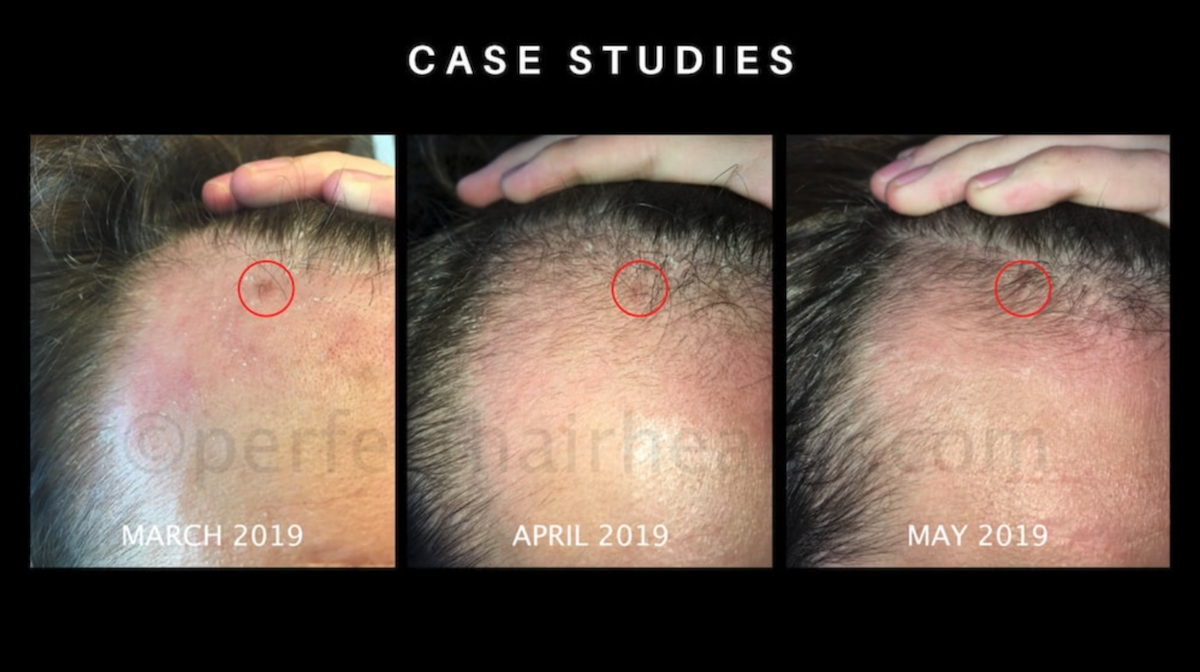
Nizoral for Hair Loss: The Side Effects
This study showed that high doses of oral ketoconazole can impair testosterone production in men, but this review article from drugs.com states that these effects haven’t been reported – even with topical ketoconazole – and seem unlikely anyway because through topical application, way too little substance is absorbed.[14]https://www.ncbi.nlm.nih.gov/pubmed/3659003[15]https://www.drugs.com/monograph/ketoconazole-topical.html
So, based on this information, you don’t need to worry about the shampoo’s effect on testosterone.
Rare side effects are summarized here. These are not prevalent, particularly if ketoconazole is formulated as a shampoo.[16]https://www.drugs.com/sfx/ketoconazole-topical-side-effects.html
All in all, ketoconazole shampoo seems to be relatively free of side effects, and a relatively safe option for those with excessive hair shedding from androgenic alopecia, telogen effluvium, or both.
For those with sensitive skin who wish to try a more natural Nizoral formulation, Sent from Earth Caffeine & Saw Palmetto Shampoo may suffice. However, this shampoo contains just 1% ketoconazole. We are not affiliated with this company; we just wanted to provide an example of what else is out there.
Who are the best candidates for Nizoral?
In regard to hair loss sufferers, ketoconazole is proven to help:
Those with androgenic alopecia
Having checked the studies above, it is pretty indisputable that ketoconazole improves AGA in humans – and not only in those who suffer additionally from seborrheic dermatitis or telogen effluvium, but clearly also in those who have only AGA. [17]https://www.ncbi.nlm.nih.gov/pubmed/9669136
Those with a hair shedding disorder (like telogen effluvium)
When TE is derived from a pathogenic microorganism, seborrheic dermatitis, or both (which can be the case), ketoconazole might help – as its anti-fungal effects can intervene in the earliest stages of seborrheic dermatitis development.[18]https://donovanmedical.com/hair-blog/2017/5/23/is-it-possible-for-seb-derm-to-cause-hair-loss
Interestingly, ketoconazole seems to improve TE regardless of its causes. We know this from the above study with 150 TE men, which showed that ketoconazole improved TE outcomes – despite the high likelihood of myriad TE causes present within that study.[19]https://onlinelibrary.wiley.com/doi/abs/10.1046/j.1467-2494.2002.00145.x
These studies are mostly on men. What about women?
To our knowledge, there are no published studies on Nizoral for hair loss in females with pattern alopecia (yet). However, one study on females found that 2% ketoconazole as a topical (not shampoo) demonstrated similar efficacy compared to 2% minoxidil over six months of use.[20]https://biomeddermatol.biomedcentral.com/articles/10.1186/s41702-019-0046-y
Given the results of this study (and ketoconazole’s suspected mechanisms of action), there is reason to believe ketoconazole shampoo is probably effective for women, as well.[21]https://www.derm.theclinics.com/article/S0733-8635(12)00093-9/abstract
You’re an ideal candidate for ketoconazole if you…
- Suffer from AGA and/or a hair shedding disorder, particularly alongside seborrheic dermatitis or symptoms of microorganism overgrowths (like excessive dandruff and/or sebum activity)
- Want the benefit of a chemical treatment without a high risk of severe side effects
- Are using minoxidil/finasteride and want to increase their efficacy
- Are performing stimulation-based therapies (i.e., massaging, microneedling, and/or platelet-rich plasma) and want to speed up the regrowth process.
Who is not a good candidate for ketoconazole?
Ketoconazole is less researched on women, although that doesn’t make it less effective. But there are contraindications for oral ketoconazole in pregnant women – and, as a precaution, the standard recommendation is for all women who intend on getting pregnant to avoid even the topical formulations.[22]https://www.drugs.com/pregnancy/ketoconazole.html
Regarding mothers who breastfeed, ketoconazole use is generally considered acceptable, but caution is recommended.[23]https://www.drugs.com/breastfeeding/ketoconazole.html
Above all, both men and women are strongly advised against the use of oral ketoconazole for the treatment of AGA/pattern hair loss. While topical/shampoo formulations have a strong safety profile, oral ketoconazole doesn’t. Consequently, it comes with a higher risk of side effects and is even banned from sale in certain countries.
Summary
Ketoconazole isn’t as well-researched as minoxidil or finasteride. However, studies show that it might be an effective add-on treatment for hair loss (specifically, androgenic alopecia).
There’s evidence that ketoconazole is almost as effective as minoxidil (Rogaine®) at increasing hair density… and that it might be particularly helpful for those with pattern hair loss with rapid hair shedding (i.e., telogen effluvium). So, if you fit within these categories, you might want to consider trying it.
Having said that, ketoconazole formulation matters. While 1% over-the-counter ketoconazole might help reduce dandruff and improve hair loss, 2% prescription ketoconazole is likely superior in its ability to improve hair loss outcomes. So, if you’re going to commit to Nizoral for hair loss, commit fully. Visit your doctor and get a prescription. Or, order online from the Nizoral Shop. Then, start shampooing.

Rob English is a researcher, medical editor, and the founder of perfecthairhealth.com. He acts as a peer reviewer for scholarly journals and has published five peer-reviewed papers on androgenic alopecia. He writes regularly about the science behind hair loss (and hair growth). Feel free to browse his long-form articles and publications throughout this site.
References
| ↑1 | https://pubmed.ncbi.nlm.nih.gov/9669136/ |
|---|---|
| ↑2, ↑7, ↑11, ↑17 | https://www.ncbi.nlm.nih.gov/pubmed/9669136 |
| ↑3 | https://www.ncbi.nlm.nih.gov/pmc/articles/PMC4367942/ |
| ↑4 | https://pubchem.ncbi.nlm.nih.gov/compound/Ketoconazole |
| ↑5 | https://www.ncbi.nlm.nih.gov/pubmed/14729013 |
| ↑6 | https://www.ncbi.nlm.nih.gov/pubmed/18498517 |
| ↑8, ↑12, ↑19 | https://onlinelibrary.wiley.com/doi/abs/10.1046/j.1467-2494.2002.00145.x |
| ↑9 | https://www.ncbi.nlm.nih.gov/pubmed/12227482 |
| ↑10 | https://www.ncbi.nlm.nih.gov/pubmed/22363845 |
| ↑13 | https://www.karger.com/Article/PDF/51628 |
| ↑14 | https://www.ncbi.nlm.nih.gov/pubmed/3659003 |
| ↑15 | https://www.drugs.com/monograph/ketoconazole-topical.html |
| ↑16 | https://www.drugs.com/sfx/ketoconazole-topical-side-effects.html |
| ↑18 | https://donovanmedical.com/hair-blog/2017/5/23/is-it-possible-for-seb-derm-to-cause-hair-loss |
| ↑20 | https://biomeddermatol.biomedcentral.com/articles/10.1186/s41702-019-0046-y |
| ↑21 | https://www.derm.theclinics.com/article/S0733-8635(12)00093-9/abstract |
| ↑22 | https://www.drugs.com/pregnancy/ketoconazole.html |
| ↑23 | https://www.drugs.com/breastfeeding/ketoconazole.html |

